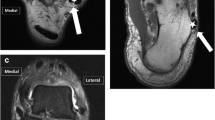Abstract
Objective
To examine the association between inframalleolar peroneal tendon abnormalities and an enlarged peroneal tubercle.
Materials and methods
Two independent readers evaluated consecutive ankle MR imaging studies to classify inframalleolar peroneal tendon findings as normal, tenosynovitis, partial tear or complete tear. The size and morphology of the peroneal tubercle was also recorded. We performed statistical analyses for inter-observer agreement and to assess differences in peroneal tubercle size between groups with and without peroneal tendon abnormalities.
Results
The study group comprised 121 subjects (mean age, 45.5 years) of whom 28 % (34 out of 121) had lateral ankle symptoms. The peroneal tubercle was absent in 56 % of subjects (68 out of 121). In subjects with a peroneal tubercle (>0 mm), the mean size was 3.5 mm (37 % triangular and 7 % plateau-shaped). Male subjects had significantly larger mean peroneal tubercle size than female subjects (2.1 ± 2.5 vs 1.2 ± 1.9 mm, P = 0.04). Overall, 26 % (32 out of 121) of subjects had some peroneal tendon abnormality: 17 % (20 out of 121) had tenosynovitis and 17 % (20 out of 121) had partial thickness tears. The peroneal tubercle size was significantly larger in subjects with peroneal tendon partial tears (P = 0.036), tenosynovitis (P < 0.001), and when both abnormalities were present (P = 0.007). ROC statistic showed 73 % sensitivity and 74 % specificity for detection of partial tears for peroneal tubercle size ≥4.3 mm.
Conclusion
Our study shows a significantly larger peroneal tubercle in subjects with inframalleolar peroneal tendon abnormalities. A cut-off of 4.3 mm showed good sensitivity and specificity for the presence of partial tears of the peroneal tendon.





Similar content being viewed by others
References
Boles MA, Lomasney LM, Demos TC, Sage RA. Enlarged peroneal process with peroneus longus tendon entrapment. Skeletal Radiol. 1997;26(5):313–5.
Hyer CF, Dawson JM, Philbin TM, Berlet GC, Lee TH. The peroneal tubercle: description, classification, and relevance to peroneus longus tendon pathology. Foot Ankle Int. 2005;26(11):947–50.
Saupe N, Mengiardi B, Pfirrmann CWA, Vienne P, Seifert B, Zanetti M. Anatomic variants associated with peroneal tendon disorders: MR imaging findings in volunteers with asymptomatic ankles. Radiology. 2007;242(2):509–17.
Choudhary S, McNally E. Review of common and unusual causes of lateral ankle pain. Skeletal Radiol. 2010;40(11):1399–413.
Lui TH. Endoscopic resection of the peroneal tubercle. J Foot Ankle Surg. 2012;51(6):813–5.
Pierson JL, Inglis AE. Stenosing tenosynovitis of the peroneus longus tendon associated with hypertrophy of the peroneal tubercle and an os peroneum. A case report. J Bone Joint Surg Am. 1992;74(3):440–2.
Bruce WD, Christofersen MR, Phillips DL. Stenosing tenosynovitis and impingement of the peroneal tendons associated with hypertrophy of the peroneal tubercle. Foot Ankle Int. 1999;20(7):464–7.
Boya H, Pinar H. Stenosing tenosynovitis of the peroneus brevis tendon associated with hypertrophy of the peroneal tubercle. J Foot Ankle Surg. 2010;49(2):188–90.
Wang X-T, Rosenberg ZS, Mechlin MB, Schweitzer ME. Normal variants and diseases of the peroneal tendons and superior peroneal retinaculum: MR imaging features. Radiographics. 2005;25(3):587–602.
Sugimoto K, Takakura Y, Okahashi K, Tanaka Y, Ohshima M, Kasanami R. Enlarged peroneal tubercle with peroneus longus tenosynovitis. J Orthop Sci. 2009;14(3):330–5.
Rademaker J, Rosenberg ZS, Delfaut EM, Cheung YY, Schweitzer ME. Tear of the peroneus longus tendon: MR imaging features in nine patients. Radiology. 2000;214(3):700–4.
Dutton P, Edmonds EW, Lark RK, Mubarak SJ. Prevalence of painful peroneal tubercles in the pediatric population. J Foot Ankle Surg. 2012;51(5):599–603.
Ochoa LM, Banerjee R. Recurrent hypertrophic peroneal tubercle associated with peroneus brevis tendon tear. J Foot Ankle Surg. 2007;46(5):403–8.
Smith JT, Johnson AH, Heckman JD. Nonoperative treatment of an os peroneum fracture in a high-level athlete: a case report. Clin Orthop Relat Res. 2011;469(5):1498–501.
Bashir WA, Lewis S, Cullen N, Connell DA. Os peroneum friction syndrome complicated by sesamoid fatigue fracture: a new radiological diagnosis? Skeletal Radiol. 2008;38(2):181–6.
Conflicts of interest
None.
Author information
Authors and Affiliations
Corresponding author
Rights and permissions
About this article
Cite this article
Taneja, A.K., Simeone, F.J., Chang, C.Y. et al. Peroneal tendon abnormalities in subjects with an enlarged peroneal tubercle. Skeletal Radiol 42, 1703–1709 (2013). https://doi.org/10.1007/s00256-013-1725-1
Received:
Revised:
Accepted:
Published:
Issue Date:
DOI: https://doi.org/10.1007/s00256-013-1725-1




